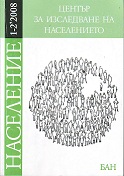СЪВРЕМЕННИ МЕТОДИ ЗА ИЗМЕРВАНЕ НА ЕФЕКТИТЕ ОТ „ОТЛАГАНОТО РОДИТЕЛСТВО“ ВЪРХУ ПЕРИОДНИТЕ ПОКАЗАТЕЛИ ЗА ПЛОДОВИТОСТ В КОНТЕКСТА НА НИСКА РАЖДАЕМОСТ
RECENT METHODS FOR MEASURING THE EFFECTS OF „POSTPONEMENT OF CHILDBEARING“ ON PERIOD FERTILITY RATES IN THE CONTEXT OF THE OBSERVED LOW BIRTH LEVEL
Author(s): Stanislava Moraliyska-NikolovaSubject(s): Social Sciences
Published by: Институт за изследване на населението и човека - Българска академия на науките
Summary/Abstract: The postponement of childbearing has been one of the major characteristics of the fertility tendencies observed in the European countries at the end of 20th century. The theory that the fertility levels will stabilize in a natural way to the level necessary for simple reproduction will difficulty happen soon because of the incoming, hardly convertible and stable changes in the fertility behavior. The impact of these unfavorable trends will have significant effect on the future reproduction of the population and its demographic structures in the coming years. In order to explore the impact of the changes in the mean age of childbearing on the fertility levels in certain calendar year, Bongaarts and Feeney (1998 and 2000) propose an alternative approach for adjustment of these „tempo distortions“. Kohler and Philipov (2001), as well as Kohler and Ortega (2002) introduce additional extensions to the formula by Bongaarts and Feeney, which allow more precise adjusting, through elimination of the „variance effects“ in addition to the „tempo effects“.
Journal: Население
- Issue Year: 2008
- Issue No: 1-2
- Page Range: 3-14
- Page Count: 12
- Language: Bulgarian
- Content File-PDF

